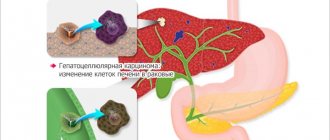After waking up, many people feel an unpleasant taste in the mouth. In most cases, this is a normal phenomenon: the human body contains many beneficial microorganisms that leave similar traces when fighting pathogens. But if a pathological coating (white) appears on the surface of the tongue, this indicates health problems, including developing gastritis.
Causes of white plaque on the tongue in adults
Digestive system diseases
- Gastritis. On the tongue with gastritis, the white coating is located clearly in the middle. Interestingly, with a low content of hydrochloric acid in gastric juice, the tongue is smooth and dry. With a high acid content it is rough. In addition, the patient experiences abdominal pain, worsening immediately after eating, and nausea.
- Enterocolitis and colitis (inflammation of the intestines). These diseases are characterized by a white coating at the root of the tongue, on the sides of which teeth marks are visible.
- Cholecystitis (inflammation of the gallbladder) or hepatitis (liver disease) is manifested by pain in the right hypochondrium and a dense white coating with a yellowish tint; it acquires a yellow tint at the root of the tongue.
- Pancreatitis (disease of the pancreas). The acute process manifests itself in the form of girdling abdominal pain, nausea and vomiting. The tongue is dry, coated with a white coating with a yellow tint. In the chronic process, the tongue is covered with a loose, snow-white coating, which appears as a result of metabolic disorders, hypovitaminosis and thrush.
Stomach ulcer. This disease is characterized by areas of desquamated epithelium on the tongue; the plaque is patchy, difficult to separate, and white-gray in color. The bloating is accompanied by “hungry” pain in the abdomen, which decreases after eating.
The disease belongs to mycoses (fungal diseases), popularly called thrush. Occurs as a result of long-term use of antibacterial agents, dysbiosis, vitamin deficiency, decreased immunity, HIV infection, and alcohol abuse. On the tongue of an adult, a hard-to-remove cheesy mass appears, a snow-white coating, the mucous membrane under which is covered with wounds.
Diseases of the tongue accompanied by a white coating
- Desquamative or “geographical” glossitis. On the tongue it manifests itself as alternating areas with a white coating with foci of smooth mucous membrane, devoid of plaque. Externally, the language looks like a geographical map, hence the name. This phenomenon occurs against the background of severe systemic diseases, allergies, and dysbacteriosis.
- Galvanic stomatitis is a disease that occurs in people with metal dentures in the oral cavity. In this case, a white coating appears, a burning sensation, and in severe cases, ulcers form on the tongue.
Diseases of internal organs
- Diseases of the bronchopulmonary system (bronchitis). White plaque is located at the very tip of the tongue, sometimes along the lateral surfaces.
- Diseases of the genitourinary system. The plaque is located near the root of the tongue and on the sides, closer to the root.
- Diabetes mellitus and pathology of the salivary glands are manifested by a white or grayish coating, dry mouth, and roughness of the surface of the tongue.
Infectious diseases
In almost any infectious process (sore throat, pneumonia, bronchitis, thrush, HIV infection), the tongue will be coated with a white coating. In this case, the buildup indicates intoxication of the body, dehydration and an inflammatory process. There are no characteristic changes in the tongue for a particular infection. It can be completely covered with a white coating, sometimes with a yellowish tint.
Harm of beef tongue and contraindications
The offal contains a high concentration of purines. This property makes it unsuitable for food for people suffering from gout. A large amount of cholesterol does not allow introducing the delicacy into the diet of patients with atherosclerosis and other vascular diseases. The product will cause more harm to such people. Beef tongue should also be limited in case of chronic diseases of the gastrointestinal tract, liver and gallbladder, and pancreatitis.
Despite all the usefulness of the food product in question, sometimes it can cause harm to human health. Just like the beneficial effects on the body, the negative ones are due to the characteristics of the chemical composition. It is not recommended to eat beef tongue if:
- Individual intolerance.
- Bronchial asthma.
- Diseases of the thyroid gland (for example, Graves' disease or endemic goiter).
- Tendency to allergic reactions.
- Diseases of the digestive system in the acute phase.
- Obesity.
If you have these health problems, you can consume the delicacy for food purposes. Provided that this will be done in limited quantities. Otherwise, there is a risk of deterioration in health. You can also consult a medical professional about the positive and negative effects of beef tongue for an individual.
Other causes of white coating on the tongue
- Nutrition. When consuming large amounts of dairy products or cottage cheese, the tongue may become coated with a white coating, which can be easily cleaned by rinsing the mouth. When consuming large amounts of carbohydrates (sugar, fruit, cakes, ice cream), bacteria actively begin to multiply on the mucous membrane, which leads to a white coating. Everything goes away after establishing a diet.
- Violation of oral hygiene rules. The tongue must be cleaned of food debris and plaque every day.
- Smoking. Chronic intoxication of the body with tobacco leads to a persistent white-gray coating on the entire surface of the tongue.
- Alcohol. In addition to intoxication, alcoholic drinks also cause dehydration. This leads to dry mouth and coated tongue.
At what age can beef tongue be given to a child?
The useful by-product must be gradually introduced into the diet of children. With its valuable properties, it will have a good effect on hematopoietic processes and support the functioning of the nervous system. Dishes made from it will help the child’s body recover from infectious diseases and cure anemia.
Initially, it is recommended that children be given dietary meats (rabbit, veal and others) as complementary foods. Only after the body gets used to the new diet and digestion does not interfere, you can try adding small amounts of beef tongue or liver to the diet. But this should be done no earlier than 8-10 months. Otherwise there will be more harm than good.
Diagnosis of the causes of white plaque on the tongue
To clarify the cause of the plaque, you need to undergo an examination. A detailed blood test and a general urine test, stool culture for dysbacteriosis, culture for microflora from the surface of the tongue, a blood test for HIV, as well as gastroscopy (examination of the mucous membrane of the stomach and the initial parts of the intestine through a probe) are required.
For proper treatment, you need to undergo an examination and find out why the tongue is white.
- If white plaque is the result of smoking, alcohol abuse, or poor oral hygiene, then treatment will consist of giving up bad habits and brushing your tongue in the morning.
- If plaque appears after eating, you should rinse your mouth after each meal.
- If diseases of the digestive tract are confirmed, treatment is prescribed by a gastroenterologist.
- Treatment of candidiasis consists of taking antifungal drugs (Clotrimazole, Fluconazole, Diflucan) orally and topically in the form of ointments.
- In the case of tongue diseases, local antiseptic drugs are used, careful oral hygiene is practiced, avoidance of spicy, hot foods and spices, smoking and alcohol. Healing preparations (sea buckthorn or rose hip oil, oil solution of vitamin A), antihistamines and vitamin preparations are applied to the mucous membrane.
Beef tongue jellied recipe
First, the offal should be boiled. This process will take a long time, about 4 hours. To ensure that the broth is clean and transparent, the first water (after 15-30 minutes) must be drained. Afterwards, rub your tongue with lemon juice to remove the smell, and put it back into the pan with clean (second) boiling water. Add onions, carrots, and a pinch of salt to make the broth clear.
Remove the finished offal, rinse with cold water and, while it is hot, remove the film. Wait until completely cooled, cut into slices at an angle. Chop the carrots: you can in the form of circles or in the form of flowers or other patterns. You can decorate with parsley, green peas, and a boiled egg cut in half.
Strain the prepared (hot) broth and dissolve the gelatin (300 ml/1 tbsp.). Place the tongue plates and other decorative elements on a dish, pour over and decorate with herbs. Place in the refrigerator.
Attention! It is recommended to store the dish for a day, no more. Otherwise, beef tongue partially loses its best nutritional properties that are beneficial to the body.
Attention! It is recommended to store the dish for a day, no more. Otherwise, beef tongue partially loses its best nutritional properties that are beneficial to the body.
White coating on the tongue
One of the modern methods for diagnosing a disease such as gastritis is based on a visual examination of a person’s tongue. The presence or absence of a white coating, various multi-colored layers, bad breath, and aftertaste on its surface is considered.
White coating on the tongue is not necessarily the cause of gastritis. Similar symptoms are observed in the event of completely different abnormalities in the gastrointestinal tract. Gastroenterologists strongly recommend differential diagnosis; it will allow one to distinguish between diseases that occur with the same symptoms.
The appearance of a person’s taste organ is an important criterion that applies not only to traditional medicine. By its appearance and color, traditional healers and adherents of unconventional methods are able to accurately determine not only the disease, but also its stage.
Chemical composition of beef tongue
Beef tongue is a unique product. It has a number of properties that are necessary and useful to us. In tsarist times, okroshka was always cooked using it. After all, it is a rich source of healthy protein, which also has an excellent taste.
| Calorie content (kcal) | 175 |
| Cholesterol (mg) | 150 |
| Water | 69,0 |
| B(g) | 16,2 |
| F (g) | 12,0 |
| U(g) | 2,3 |
| Vitamins: | |
| B2 (mg) | 0,32 |
| B5 (mg) | 1,99 |
| B12 (mcg) | 4,75 |
| PP (mg) | 7,6 |
| Macro- and microelements: | |
| Zinc (mg) | 4,85 |
| Chromium (mcg) | 19,2 |
| Molybdenum (µg) | 16,1 |
| Iron (mg) | 4,2 |
| Chlorine (mg) | 250,5 |
| Phosphorus (mg) | 223,3 |
| Potassium (mg) | 254,5 |
| Phenylalanine Tyrosine (g) | 1,19 |
| Tryptophan (g) | 0,19 |
| Threonine (g) | 0,72 |
| Methionine Cysteine (g) | 0,65 |
| Lysine (g) | 1,37 |
| Leucine (g) | 1,23 |
| Isoleucine (g) | 0,78 |
| Histidine (g) | 0,61 |
| Valin (g) | 0,86 |
We should probably return to the traditions of our ancestors. After all, there is so much in the sausage that is produced today! A whole set of additives with toxic properties: sodium nitrite, flavorings, flavor enhancers, monosodium glutamate, leather, soy, cartilage! They make okroshka harmful and make it a dangerous product for health. Isn't it better to cook the dish in the old traditional way with beef tongue, the properties of which are undoubtedly beneficial?
Diagnosis of a person’s condition by language
Therapists at the reception often ask the patient to show his tongue. This is done in order to find out about the presence of a pathology that requires treatment. There are a number of signs by which it is customary to judge a person’s state of health; they are visible even to the naked eye.
During preliminary diagnosis, pay attention to such signs as:
- the color of the tongue, which should be pink (only minor deviations in color are acceptable);
- on the surface of the tongue you can clearly see the taste buds, which should be evenly distributed over the entire surface;
— absence of any layers, except for a small transparent layer;
— the moderate moisture of the tongue is clearly visible, and any odors are completely absent.
With the described condition of the tongue, it is possible to talk about normal health, the complete absence of any inflammatory processes, both acute and chronic.
If there is any pathology, the overall picture of the condition of the tongue can change dramatically:
- a simple visual inspection reveals a coating on the tongue; the surface may have a different color that does not correspond to the normal state of the body;
- plaque, indicating the occurrence of an inflammatory or purulent process, so dense that it does not allow the taste buds to be seen;
- intolerable odor emanating from the mouth, either distinct or slightly noticeable.
There are also other symptoms of the disease, depending on its nature. These include inflammation of the tongue, burning, an extremely unpleasant, even disgusting, quickly spreading odor, a white coating on the tongue, the high density of which does not allow it to be eliminated by conventional methods.
Plaque formed on the tongue can be the result of various diseases that are completely unrelated to the functioning of the gastrointestinal tract. Only if the tongue is coated, there are other symptoms most characteristic of gastritis, can we make the assumption that the person is sick.
What it is
Beef tongue is an offal of the first category and it is muscle tissue. It is completely free of partitions, fibers and films. Thanks to this, its structure is very delicate. Its weight is approximately 0.2-2.5 kg .
The calorie content of the product is approximately 170 calories per 100 grams . The delicacy has a very rich chemical composition. It contains vitamins: almost all from group B, as well as E and PP.
Beef tongue contains large quantities of calcium, magnesium, potassium, molybdenum, zinc, phosphorus, iron, chromium, iodine, copper, sodium and other macro- and microelements necessary for the normal functioning of the human body. In addition to all this, there are various extractives.
The product contains little cholesterol: no more than 150 mg per 100 grams of delicacy .
How various diseases affect the appearance of the tongue
The coating that appears on the tongue has different colors and shades, and its density varies. Such signs depend on the stage of the disease, the form of the pathology, the characteristics of the manifestation of the disease and the factor causing it. It is by this factor that it is customary to distinguish between the types of gastritis.
Click here - all materials about Gastritis
Differential diagnosis can determine the type of provocateur causing the development of the disease. It is carried out to understand what stage the disease has reached, to choose methods of treatment, and to prescribe the necessary therapeutic diet.
The doctor can make a preliminary diagnosis based on the condition of the patient’s tongue, namely:
- according to the density of the plaque consistency (if the density is loose, it is easy to remove, it means that the inflammatory process is at the initial stage, for treatment it is recommended to use medications prescribed by a doctor, the therapeutic diet may have only minor restrictions);
- a dense, cracking plaque with a cheesy appearance can mean serious inflammation of the mucous membrane, especially if there is bad breath;
- in case of a viscous coating that occupies the entire tongue except the very tip, accompanied by dryness and burning, an exacerbation is diagnosed, requiring urgent measures for treatment;
- a clear sign of an exacerbation of an ulcer is considered to be a yellow or yellow-orange color of plaque with red spots, which may indicate the presence of stomach acid in the mouth;
- the tongue is grayish-white in color, the heterogeneous consistency of the plaque, in which plaques are visible in the form of individual islands of greater density, may mean that the disease has reached a chronic form caused by a bacterial infection;
- a grayish color of the tongue and a dense coating occurs in cases where inflammation of the mucous membrane is provoked by the use of certain medications; such gastritis is often called medicinal gastritis.
Monitoring the condition of the patient’s tongue is important not only for the attending physician, but also for the patient. Knowing the diagnostic criteria determined by the tongue, the patient will be able to assess his physical condition. Plaque in any form that appears on the tongue becomes a good reason to start taking medications prescribed by the doctor and strictly adhere to the prescribed diet, as well as seek qualified help if dangerous symptoms of a serious illness occur.
Tips and how to properly cook, store and consume
You need to know how to cook offal correctly. This will preserve all its beneficial qualities.
- to soak the product in water before the cooking process . For at least 30 minutes . The best option is to leave the beef tongue in water for an hour.
- If there is any dirt or mucus left on the product, it must be scraped off with a knife. Then it must be rinsed thoroughly again.
- Cooking time can vary from 2 to 4 hours . This will depend on the size and age of the animal. Readiness is checked as follows: the delicacy is pierced with a fork and if the juice that comes out is clear, the product is ready.
Often the beef tongue is quite large and they buy it whole. It can be cut into pieces and placed in the freezer of the refrigerator. This way it can be stored for a long time.
The boiled delicacy should be stored in the refrigerator, first wrapped in foil. It will be usable within 2-3 days .
As for the daily consumption rate, it is 150 grams . During pregnancy, it should be reduced to 80 grams (after all, the product is quite rich in terms of chemical composition). Also, this amount should be adhered to if there are points regarding potential harm.
Plaque on the tongue, what are the causes
When a changing color of the tongue appears and plaque forms, a fetid odor of varying intensity, a burning sensation in the tongue, an assumption is made about the presence of some pathological processes that have arisen in the coolant (gastric mucosa). They may indicate its damage or the possibility of penetration of a harmful agent, which is often observed in such dangerous types of disease as erosive, phlegmonous, etc. Such cases require the patient to visit a doctor and strictly adhere to the course of treatment prescribed by a qualified doctor. Under no circumstances should you try to eliminate the symptoms of the disease using various medications.
The appearance of high-density plaque on the tongue, as well as other signs described above, requires an immediate response from a person. Even in the case of diagnosed gastritis, such symptoms can be the cause of other diseases, even those not associated with disturbances in the functioning of the digestive system.
What diseases can cause changes in the condition of the tongue:
- a gray coating, which is accompanied by dryness, lack of saliva, the appearance of cracks, may accompany any infectious disease, for example, similar symptoms are noticed with dysentery;
- white coating on the tongue, on which pimply spots are visible, traces of erosion that has occurred on the oral mucosa are a manifestation of galvanic stomatitis;
- with a sore throat or any inflammation of the throat, a white coating also appears on the tongue;
- plaques formed on the tongue are usually associated with a fungal disease; they can be a sign of thrush or indicate pathological phenomena in the endocrine system, when small ulcers can be detected.
It is best to examine the tongue and plaque in the morning. It is caused by bacteria and microorganisms that are always present in the human body in huge quantities. It is they who form the main layer of plaque, consisting of the products of their vital activity, dead cells of the oral mucosa, an aggressive environment filled with dead microbes, metabolic products, and various types of mucus. During the night, when the mouth and the entire digestive system are inactive, this layer can be examined more carefully, since it is especially noticeable during these hours.
Beef for gastritis with high acidity - recipes for preparing beef dishes
Meat is an important food product for the whole body, including the stomach.
The dietary menu may consist of chicken, rabbit, veal and turkey. The total calorie content of the diet should not exceed 2000 kcal. It is undesirable to eat beef (with the exception of veal), as it can injure the gastric mucosa. But if you cannot refuse it, then you need to cook it boiled, stewed or steamed. Recommended chopped steam cutlets, portioned pieces of meat. Energy value is 200-250 kcal for every 100 grams.
Meat is an important food product for the whole body, including the stomach.
Veal is a fairly tender food, containing, in addition to protein, a large amount of macro and microelements, B vitamins. Chicken or turkey meat should not be tough. Rabbit meat is one of the most popular dietary meat products. It has a minimal amount of cholesterol and fat. At the same time, there is more protein in rabbit meat than in chicken meat, and is absorbed by the body by 95%.
Beef is considered a heavy food that takes time for the stomach to digest. Therefore, dietary beef dishes for gastritis are best consumed at lunch. They will have time to digest before you go to bed. Since beef for gastritis is a lean type of meat, it can be consumed boiled, stewed, or steamed. Beef tongue is considered a real delicacy.
It is preferable when beef with gastritis with high acidity is ground into minced meat. Cutlets, steamed zrazy, meatballs, and soufflé are prepared from it. When remission has occurred, you can stew and bake the meat in a slow cooker in small pieces.
The benefits of beef meat in human nutrition are great, but in some cases it must be consumed carefully, in moderate or limited quantities. This applies to people who have gastrointestinal diseases. If you have gastritis, you can eat beef, but only if it is the meat of a young animal. Doctors advise eating this type of meat at lunchtime so that it is absorbed better and faster. Beef can be consumed boiled, stewed or baked.
With gastritis, most of your favorite dishes will have to be put aside. But dietary food can also be varied and tasty. Gastroenterologists allow the consumption of beef; it is not only harmless, but will also bring a certain amount of benefit to the functioning of the stomach. During an exacerbation of the disease, you are not allowed to eat anything at all, and you won’t want to, but a week after it, beef can safely be included in the patient’s diet. It is preferable to consume it separately from other products, stewed or boiled, without spices or frying.
Gastritis with high acidity is accompanied by increased secretion of gastric juice, which contains a lot of hydrochloric acid and enzymes. In a healthy person, about 1.5 liters of gastric juice are secreted in the stomach per day, and in this form of the disease it is 2-3 times more. In treating this disease, proper nutrition is of great importance.
To do this, include foods that reduce acidity in your diet. Milk cereal soups with the addition of vegetables (except cabbage) are recommended; chopped vermicelli or homemade noodles; milk, cream, fresh non-acidic sour cream, fresh non-acidic cottage cheese, soft-boiled eggs or in the form of a steam omelet (no more than three per day);
Ingredients: beef 110 grams, milk 25 grams, flour 6 grams, egg 1/4 piece, butter 5 grams.
Boiled beef meat minced three times
Boil the meat until cooked, remove films and tendons, and pass through a meat grinder twice. Combine the minced meat with bechamel sauce, stir, add the yolks, butter, stir, then carefully fold in the whipped whites into the mixture. Stir and place in a greased form. Place in a water bath and bring to readiness. Instead of bechamel sauce, you can use sour cream or milk sauce.
Ingredients: beef 110 grams, sour cream sauce 40 grams, butter 5 grams.
Pass the boiled meat through a meat grinder three times, add sour cream sauce, and grind thoroughly. Instead of sour cream sauce, you can add meat broth. Serve the puree with butter. Cooked meat puree can be added to slimy or pureed soup.
Products: beef 115 grams, wheat bread 25 grams, milk 25 grams, egg 1/4 piece.
Prepare a cutlet mass from the meat, place it on a damp gauze with a 2 cm layer. Place hard-boiled and finely chopped eggs in the middle along the edge of the cutlet mass. Lifting the gauze on one side, connect the edges of the cutlet mass, place it on the grate of a steam pan along with the gauze, and cook.
Ingredients: beef 110 grams, butter 7 grams, flour 7 grams, milk 60 grams, sour cream 20 grams, tomato juice 20 grams, herbs 5 grams, salt.
Boil the meat, cool it and cut into small oblong pieces. Prepare a white sauce, pour it over the meat, add tomato juice, salt and stir. Cook at low boil for 10 minutes, then add sour cream. When serving, add a piece of butter and sprinkle the beef stroganoff with finely chopped herbs.
Every person diagnosed with gastritis carefully monitors their diet. Of particular concern in this case is the question of whether it is possible to eat steamed meat and how to cook it for people suffering from gastritis? In order to maintain your health and at the same time eat properly, it is recommended to eat steamed meat.
Traditionally, when cooking meat by frying, a certain amount of vegetable oil is required. As a result of its use, dangerous compounds are formed - carcinogens. And when processing meat with steam, no oil or broth is used, and all water-soluble minerals and vitamins are retained in the product. Thanks to this cooking method, the total calorie content of the dish and the time required to prepare meat products are reduced.
This is due to the fact that eating steamed dishes significantly reduces the feeling of hunger, allowing you not to overfill your stomach and reducing the continuous craving for tasting a variety of dishes. After all, meat dishes from chicken and beef turn out to be extremely healthy and juicy, since the steam itself eliminates the presence of impurities of various metals.
Steamed beef is a traditional recipe for gastritis. To prepare it you will need:
- beef fillet 300-350 gr.;
- cream 150 ml;
- water 1.5-2 l;
- salt to taste.
The meat must be washed and cut into pieces against the grain. The thickness of the pieces is approximately 2-2.5 cm. Salt and pour cream for half an hour.
Steamed beef cutlets
Place the marinated fillet in a steamer and cook on the appropriate setting until the end of the program. As a side dish for meat, you can use steamed vegetables and cereals, such as rice or buckwheat.
Ingredients for cooking:
- any lean meat 400-500 g;
- egg 1 pc.;
- milk 100-150 ml;
- bread crumbs 120 g;
Rinse the meat fillet thoroughly and chop finely in a meat grinder or blender. Pre-fill the crackers with a small amount of water for 3-5 minutes. Add the swollen breadcrumbs, milk and egg to the prepared minced meat, then mix well. Form cutlets from the resulting mixture and place in a steamer. When serving, you can garnish with fresh herbs.
The recipe is very simple! Chop the onion and place it in a dry pan in a layer of about 2-2.5 cm. Cut the meat across the grain into pieces 0.5 cm thick and place it on the onion, sprinkling each layer with a little salt. The last layer can be sprinkled with lemon juice, but this is not necessary. Cover the saucepan with a lid and place on the lowest heat. Do not open the lid for an hour!!! During this time, the meat is first stewed in onion and its own juice, and the onion turns into a paste in the form of a sauce.
Good served with buckwheat, mashed potatoes, etc. When dieting for gastritis, eat this meat without a side dish, because in fact it is not fried and absolutely free of fat. For adults and those not burdened with a diet, you can add more spices, although the meat already has an extraordinary taste!
- beef-300 grams;
- onions - 3 pieces;
- lemon juice-2 tbsp. (not necessary).
A person normally has a moderately moist light pink color.
If a person is not tormented by various diseases, then his tongue can be distinguished by the following characteristics:
- moderately moist light pink color;
- small taste buds;
- An almost transparent pink coating may be observed in small quantities.
In addition, there is no bad breath. If any of the above signs are abnormal, it is recommended to consult a doctor and undergo the examination prescribed by him to determine the reasons that caused these changes.
The type and condition of the white plaque will indicate in more detail the nature and stage of the problem
About other signs of disease
A burning sensation in the tongue is a fairly common symptom in other pathologies, so until the exact causes of its occurrence are clarified, it is premature to draw conclusions, which may turn out to be hasty and incorrect.
Sometimes, in order to find out the exact cause of the burning sensation, consultation with such specialized specialists as a neurologist or gastroenterologist may be required, or an examination by a dentist may be required.
Despite the fact that an oppressive burning sensation most often occurs with the development of inflammation in the gastric mucosa, the presence of diagnosed gastritis, proper treatment, and compliance with all diet rules is not always the reason for its occurrence. With an equal degree of probability, a burning sensation can be caused by both inflammation in the gastrointestinal mucosa and a similar process in the oral mucosa, which is provoked by a source of infection.
When there is a burning sensation in the tongue associated with the infectious disease glossitis caused by bacterial or viral microflora, it is not enough to carry out only symptomatic treatment; it is necessary to eliminate, first of all, the source of the infection itself, which provokes its occurrence and chronic course.
In order for a burning sensation to appear in the tongue, several reasons can be given, namely:
- use of dentures that are incorrectly fitted and constantly injure the mucous membrane;
- allergic reaction to dental and oral hygiene products;
- presence of fungal infections and caries in the mouth.
All of these reasons not only disrupt the calm flow of life, but can pose a serious danger that has a negative impact on the functioning of internal organs.
We must not forget that a burning tongue is sometimes caused by cancer, or disruptions in the functioning of the endocrine system, for example, diabetes, as well as neurological disorders.
A tongue that is densely coated (white coating on the tongue), or a burning sensation that often occurs in it during gastritis, is a signal of the physical condition of the human body and helps determine the phase of the disease. It must be remembered that there are a large number of different reasons that can cause such symptoms. This should make you think that it is necessary to first understand the true cause of the unpleasant sensations that have arisen before making any decisions regarding the diagnosis, choice and course of treatment.
Gastritis is one of the most difficult to treat serious diseases. Moving into the acute phase or when a complication occurs, it requires constant medical monitoring. Only constant observation by a qualified specialist who prescribes treatment and a therapeutic diet based on the patient’s condition is the only sure way to effectively get rid of the disease.
Benefit
Such a rich composition is responsible for the many great benefits of beef tongue. It includes the following:
- Normalizes the functioning of the nervous system - thanks to the high content of B vitamins, it improves the conductivity of nerve impulses.
- Stabilizes the psycho-emotional background - eating beef tongue promotes the formation of proteins, hormones and amino acids necessary for the normal functioning of the nervous system.
- A valuable dietary product - as it is low in calories.
- Useful for diabetes - it alleviates the general condition by helping the production of insulin.
- Indispensable for pregnant women - in their situation, it is very important for their bodies to receive a whole range of necessary substances.
- Promotes recovery after complex illnesses - and even after surgical interventions.
- Accelerates wound healing - due to the large amount of zinc in the composition.
- Stabilizing cholesterol levels and reducing them - this also requires zinc.
- Eliminates migraines - thanks to nicotinic acid.
- Useful for gastritis, ulcers and iron deficiency anemia - helps in the treatment of these diseases.
- A valuable food product for athletes - quickly restores strength .
- Excellent for feeding children and adolescents - during the phase of active growth and puberty it is very important to receive all the necessary substances.
- Improves the condition of hair, nails and skin - because with a lack of vitamins and macro- and microelements it can worsen.
In addition, the product in question can be an excellent alternative to regular meat. After all, beef tongue is much easier to digest. Combined with numerous healing qualities and excellent taste, this makes this delicacy a doubly welcome guest on the dinner table.
The condition of the tongue as a reflection of the condition of the gastrointestinal tract
The tongue and its appearance can tell a specialist without words how your gastrointestinal tract works. If you are a healthy person, your tongue will have a pale pink color and a velvety, evenly colored surface. You probably remember how, during medical examinations, doctors ask you to show your tongue, sticking it out as far as possible. Although this may seem funny, in fact the doctor is not doing this to cheer himself or you up. He pays attention to the size of the tongue and checks for swelling and tooth marks on its surface.
Thus, the doctor can diagnose inflammation of the gum mucosa (gingivitis, stomatitis, myxidema) and acromegaly - hormonal imbalance. Dryness of the surface of the tongue can be a consequence of acute infectious diseases: influenza, typhoid fever or sepsis. It can be caused by uncontrollable vomiting, diarrhea, peritonitis and polyuria. The condition of the superficial papillary layer and the color of the tongue can also serve as symptoms of internal diseases:
dysfunction of the digestive system
But doctors pay special attention to such a phenomenon as a coated tongue, when its entire surface or individual local areas are covered with a dense white or yellowish coating - this is a symptom of many gastrointestinal disorders.
Is it possible to eat beef tongue during pregnancy and breastfeeding?
One of the most common problems of expectant mothers is low blood hemoglobin. The problem cannot be ignored, otherwise delay will harm the developing fetus. To quickly increase your red blood cell count, it is enough to introduce beef tongue into your diet, the benefits of which for pregnant women are undeniable.
The benefits of boiled beef tongue will be obvious during the postpartum period. However, it should not be immediately introduced into the diet of a nursing mother. This will harm the baby. Substances that get into milk can cause digestive disorders in the baby and the appearance of colic in the abdomen. Therefore, it is better to wait until the baby reaches 3 months of age.
Attention! Beef tongue will also be very useful for a nursing mother: it will restore strength, give energy to care for the baby, and replenish missing nutrients in the body.
Attention! Beef tongue will also be very useful for a nursing mother: it will restore strength, give energy to care for the baby, and replenish missing nutrients in the body.
Reasons for the formation of white plaque on the tongue
The white coating that appears on the tongue in healthy people in the morning is desquamated epithelium and a small amount of bacteria and their waste products accumulated during a calm, immobile state, which are washed off with saliva during wakefulness. These bacteria, both beneficial and pathogenic, live in any organism and take an active part in many processes. The remaining accumulate in the inner cavity of the mouth, on the surface of the gums, tongue and teeth; you remove them in the morning during daily hygiene procedures.
You should clean the plaque on your tongue using light circular movements, being careful not to damage the tissue. Do this before breakfast to prevent bacteria from your tongue from entering your body.
But there are other, more serious reasons for the formation of such plaque. An increase in its thickness or the appearance of a grayish tint indicates a decrease in immunity, in which the number of pathogenic bacteria increases. The fact that you need to check your respiratory system may be indicated by a white coating concentrated on the tip of the tongue or along its edges; sometimes such a coating can be seen on the tongue of a heavy smoker. But the appearance of local areas of white plaque on the root of the tongue or its lateral surfaces at the base may be a sign of incipient kidney disease. Fungal diseases, in particular candidiasis or thrush, are manifested by a pronounced white coating with a cheesy structure. One of the symptoms of a severe sore throat is a thick coating on the entire surface of the tongue, as a rule, the patient’s temperature rises, the tonsils become enlarged and difficulty swallowing occurs.
© Westend61/Getty Images
However, most often a white coating on the tongue is a symptom of dysfunction of the gastrointestinal tract. If teeth marks are visible on the plaque in the morning, this is most likely a sign of poor digestion of food by the intestines. When a dense white coating is concentrated in the middle part of the tongue, and cracks are visible on it, there is a danger of gastritis. In some cases, you can adjust your menu and diet yourself, but it’s still better to see a gastroenterologist and get the necessary recommendations from him, and, if necessary, treatment.
Useful properties of the language
Beef, lamb and pork tongue contains magnesium, iron, calcium, potassium, sodium, copper, manganese, cobalt and a certain amount of vitamins B1, B2, B6, PP. The skin of the tongue must be removed after boiling. The tongue contains little connective tissue and is therefore easily digestible.
The nutritional value of offal varies. The most valuable are the liver, heart, tongue, brains, and kidneys.
The value of the by-product is explained by its composition. Due to the rare beneficial compounds in its composition, it is able to restore the chemical balance in the body, which ensures good health and a strong immune system.
Beef tongue is a rich source of healthy, easily digestible protein, which makes it a dietary product. It also contains a significant amount of iron, which ensures the exchange of oxygen between internal organs and the environment. In addition, it contains vitamin B12, a deficiency of which can cause irreparable harm to the hematopoietic system in the human body.
There is zinc, thanks to the properties of which our sex hormones and pituitary gland function fully. There is nicotinic acid (NA), a deficiency of which in the body stops properly synthesizing our main energy substance - ATP, which, accordingly, causes harm to the body: dermatitis, dementia or diarrhea occurs and, as a result, insufficiency of the gastrointestinal mucosa.
For the better half, the offal will help improve the properties of the skin, maintain a girlish figure and achieve a smooth, calm state of the nervous system, and a restful sleep. Active compounds renew and regenerate skin cells from the inside, preventing them from losing their elasticity and freshness.
The protein contained in the offal will help quickly build muscle mass during sports, as well as provide the body with a large supply of energy and strength, so necessary for intense physical labor, an active and successful life.
The benefits of veal tongue and its properties make it possible to include the product in low-calorie diets for weight loss. It contains a small amount of fat and an abundance of easily digestible protein. All this makes it a valuable dietary product. In addition, due to the content of beneficial compounds (B vitamins and others), it improves carbohydrate and fat metabolism.
Dishes made from this by-product tend to satisfy hunger well, which allows you to gradually reduce the amount of food consumed. At the same time, the quality of nutrition does not suffer, and the body is not harmed. Beef tongue contains most of the necessary and beneficial substances.
In addition, the offal contains compounds that improve the functioning of the digestive tract. First of all, its use benefits the gastric mucosa, preventing the development of gastritis {amp}amp;#8212, one of the unpleasant consequences of sudden changes in diet.
Attention! When dieting, the benefits of beef tongue will be maximized if it is consumed boiled.
The cost of beef tongue is higher than that of pork tongue. This is explained by the fact that in terms of its taste and nutritional properties it is better and richer, giving the body more benefits. Its delicate, refined taste and unique composition have long identified beef tongue as a delicacy.
Pork offal is somewhat smaller in size. It contains more fat. For those who suffer from extra pounds or diabetes, veal offal will be preferable, because in terms of its performance it is more suitable for low-calorie diets.
Attention! The health benefits of beef tongue are more pronounced than those of pork. People suffering from any diseases should prefer this option.
In addition, the offal contains compounds that improve the functioning of the digestive tract. First of all, its use benefits the gastric mucosa, preventing the development of gastritis - one of the unpleasant consequences of sudden changes in diet.
Attention! When dieting, the benefits of beef tongue will be maximized if it is consumed boiled.
Attention! The health benefits of beef tongue are more pronounced than those of pork. People suffering from any diseases should prefer this option.
Do I need to remove white deposits?
You can simply clean that light, odorless white coating that forms in the morning with a special brush or toothbrush. But changes in his condition, which are a consequence of health problems, cannot be ignored, especially when an unpleasant odor appears and the color of the plaque changes to yellow. In these cases, the root cause of the appearance of such plaque should be found and eliminated, after which it will disappear on its own.
If the condition of the white plaque changes, the first doctor you should visit is a general practitioner - after examining your tongue, he will be able to determine which specialist to refer you to
You need to be examined by medical specialists and undergo tests, based on which you will be diagnosed. If you notice the pathology in a timely manner and seek medical help in time, you may not need any medications. Thus, incipient gastritis can be easily stopped and cured only with the help of a therapeutic diet.
Treatment
A set of therapeutic methods is aimed at combating the root cause of gastritis.
Diet
Dietary nutrition excludes the intake of spicy, salty, fatty foods, and alcohol. For food processing, preference is given to boiling, baking or steaming.
The choice of products should be in favor of:
- easily digestible food;
- low-fat fish and meat broths;
- fresh herbs;
- fruit and vegetable juices that do not irritate the mucous membranes;
- fermented milk products.
The diet must also be combined with:
- drinking a volume of liquid of at least 2 liters, mineral still water;
- five meals a day;
- taking medications prescribed by a gastroenterologist.
In almost 90% of cases of gastritis, it can be treated with conservative methods.
Medicines
The prescription of medications is aimed at eliminating the provoking factors of gastritis.
- For bacterial infections, antibacterial drugs are prescribed: Tetracycline, Cephalexin, Neomycin.
- Acute gastritis due to poisoning: antispasmodics and enterosorbents.
- Catarrhal pathology: bismuth enveloping preparations and belladonna-based painkillers.
Depending on the acid level, the following drugs are prescribed:
- Elevated levels: antacid sodium bicarbonate, calcium carbonate, bismuth nitrate. Anticholinergics: Gastrocepin, Metacin. Antispasmodic No-shpa. To stimulate gastric motor activity Cerucal.
- Reduced level: drugs that enhance gastric secretion - Plantaglucide. Enzymes: Pancreatin, Festal. To improve trophic processes Methyluracil.
To get rid of the symptom of bitterness in the mouth, pharmacologists have developed a large number of remedies. They relate to symptomatic treatment and cannot be used constantly, especially without consulting a doctor.
Suitable for a single dose:
- Ultatop is a product that blocks the production of large volumes of acid, which irritates the mucous membrane. The active substance is omeprazole. Release form: capsule and ready-made solution for intravenous administration. Contraindicated in pregnancy, children under 12 years of age, galactose intolerance.
- Almagel a is a drug based on aluminum and magnesium hydroxide, which has a neutralizing effect on gastric juice, anesthetizes and envelops the stomach from the inside, and significantly reduces the feeling of bitterness and heartburn. Available as a suspension. Unlike many drugs, it is approved for pregnant women and children from 1 month. Contraindicated in severe renal pathology, hydrocyanic dementia.
- Ontime – suppresses excess acid produced regardless of food intake. The active ingredient is rabeprazole sodium. Available in enteric-coated tablets. Prohibited during pregnancy and in people with sensitivity to the composition.
- Maalox – absorbs and envelops the gastric walls. Two active components: aluminum oxide and magnesium hydroxide. The form of production is chewable tablets with a lemon flavor. Cannot be used for severe renal pathologies, hypophosphatemia, fructose intolerance, intolerance to the constituent components.
- Almol is an antacid that coats the walls of the stomach. Active elements: magnesium hydroxide and alhydrate. Release - gel or suspension. Has contraindications: pregnancy and lactation, renal failure, sensitivity to the composition, Alzheimer's disease.
- Rennie is an antacid with an immediate effect of 3 minutes. Contains calcium and magnesium carbonate. Not recommended for children under 12 years of age, patients with renal impairment, or intolerance to components.
ethnoscience
To use alternative medicine recipes, you must undergo a full examination and consult a doctor.
Herbal recipes have been known since ancient times, when people were looking for all sorts of ways to combat bitterness in the mouth. Among them:
- flaxseed infusion;
- decoction of corn silk;
- rinsing your mouth with chamomile or sage infusion;
- drinking freshly squeezed potato juice;
- oatmeal jelly;
- a decoction of lingonberry leaves and coltsfoot flowers;
- dill infusion;
- honey.
Treatment of bitterness accompanying gastritis requires following a diet, eliminating the primary causes and following all the specialist’s prescriptions.
Oral hygiene and odor removal
With gastritis, not only plaque appears, but also an accompanying odor that is unpleasant both to those around you and to yourself. To get rid of both, you should follow a few simple rules:
- Teeth should be brushed at least twice a day;
- Learn to use dental floss; cleaning the space between your teeth should be done daily;
- You also need to clean your gums, and especially your tongue. In no case is this done with the main bristles of the toothbrush: this will only damage the mucous membrane;
- You can buy special fresheners and rinses, or rinse your mouth with decoctions of chamomile, mint, and sage. You can rinse both before and after cleaning. When buying a freshener, pay attention to the composition: chlorine dioxide will help cope with bacteria at the base of the tongue, which you cannot reach on your own;
- Eat “slow carbohydrates” to get rid of ketones and, accordingly, bad breath caused by their deficiency and the breakdown of fats. For gastritis, baked apples and bananas are ideal for this.
Based on all of the above, let’s summarize: the coating on the tongue itself is not dangerous, but the reasons for its appearance can be very diverse and serious. Maintain good oral hygiene, do not forget to visit specialists periodically and be healthy!
According to statistics, this phenomenon occurs more often in women over 40 years of age, but not all cases depend on gender and age. The symptom of a burning tongue can suddenly complicate the life of both an adult and a child, and haunt a person for many years.
The sensation of a burning tongue is not an independent disease: this symptom means that there is a problem in the body. They can be either local or general. Therefore, sometimes when there is a burning tongue, symptomatic treatment is sufficient , but more often it is necessary to establish the cause of the symptom through a comprehensive examination and eradicate it.
Treatment
If you notice persistent symptoms, the patient should seek help from a doctor. If there are disorders of the respiratory tract, then it is necessary to consult an ENT doctor, if you have diabetes mellitus - to an endocrinologist, if there are disturbances in the structure and functionality of the gastrointestinal tract - to a gastroenterologist.
First of all, before prescribing treatment, the doctor must conduct a full examination to find out the cause of the symptoms. After instrumental and laboratory tests, the patient is prescribed a course of therapy using a therapeutic diet.
In case of diseases of the digestive organs, you must follow simple rules of a healthy diet and lifestyle in order to eliminate unpleasant symptoms:
- you can cook jelly from flax seeds for the patient and drink it after meals, when bitterness appears;
- use natural sedatives that can be made from herbs - valerian, motherwort and peony;
- drink freshly squeezed vegetable juices from carrots, potatoes, celery, parsley;
- drink at least 2 liters of clean water per day;
- exclude all fatty, fried, smoked foods;
- reduce the amount of sweets and chocolate in the diet;
- Patients are allowed to eat cereals, fruits, and vegetables.
As part of therapy, the patient needs to give up bad habits.
If bitterness and dryness in the mouth appear infrequently, but only sometimes, then one can suspect that these symptoms appear due to the dry air in the room. In such cases, it is recommended to install an air humidifier in the room. To prevent your lips from drying out, it is recommended to use special balms.
To get rid of the unpleasant odor, doctors advise rinsing the mouth after each meal and chewing gum (you need to be extremely careful with unnatural products, since excessive chewing can provoke the appearance of additional gastric juice, which will provoke pathological changes in the gastrointestinal tract).
You can also activate the functions of the salivary glands with hot pepper, but its addition to food should be minimal, because the product can have a negative effect on the stomach.
Prevention
To avoid the appearance of a bitter taste in the mouth and xerotomy, it is recommended:
- timely treatment of infectious-inflammatory and dental diseases, elimination of digestive problems;
- normalization of work and rest regimes;
- refusal of heavy (fried, fatty, etc.) foods, smoking and alcohol;
- air humidification in working and living areas;
- control of the psycho-emotional state to avoid the occurrence of neurological problems.
Thus, the feeling of bitterness and dryness of the oral mucosa are signals notifying about various malfunctions in the body. As a rule, the “culprits” are diseases of the digestive tract (especially the biliary tract), but the problem can also be caused by dental, respiratory, hormonal and neurological disorders. In any case, when the discomfort is not temporary, but permanent, accompanied by thirst, vomiting, abdominal pain and other unpleasant symptoms, it is necessary to seek help from a doctor and undergo treatment.











